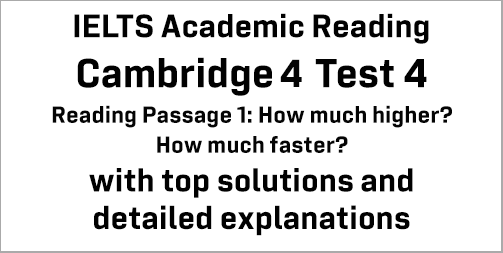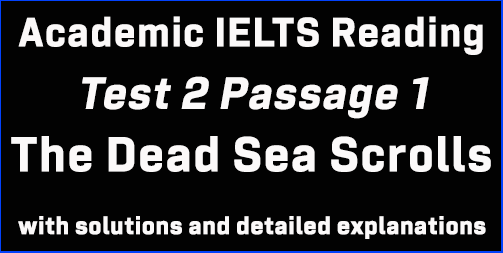IELTS Academic Reading: Cambridge 4 Test 4 Reading passage 1; How much higher? How much faster?; with top solutions and best explanations
This Academic IELTS Reading post focuses on solutions to IELTS Cambridge 4 Reading Test 4 Reading Passage 1 titled ‘How much higher? How much faster?’. This is a target post for IELTS candidates who have huge problems finding out and understanding Reading Answers in the AC module. This post can help you the best to comprehend every Reading answer very easily. Finding out IELTS Reading answers is a steady process, and this post will assist you in this respect.
IELTS Cambridge 4 Test 4: AC Reading Module
Reading Passage 1: Questions 1-13
The headline of the passage: How much higher? How much faster?
Questions 1-3: TRUE, FALSE, NOT GIVEN
[In this type of question, candidates are asked to find out whether:
The statement in the question agrees with the information in the passage – TRUE
The statement in the question contradicts with the information in the passage – FALSE
If there is no information on this – NOT GIVEN
For this type of question, you can divide each statement into three independent pieces and make your way through with the answer.]
Question no. 1: Modern official athletic records date from about 1900.
Keywords for the question: modern official athletic records, date, about 1900,
The very first lines of paragraph no. 1 give us the answer to this question. The author says here, “Since the early years of the twentieth century, when the International Athletic Federation began keeping records, . … .”
Here, Since the early years of the twentieth century = date from about 1900, began keeping records = records,
The lines are a clear match with the question.
So, the answer is: TRUE
Question no. 2: There was little improvement in athletic performance before the twentieth century.
Keywords for the question: little improvement, athletic performance, before, twentieth century,
In lines 5-12 of paragraph no. 1, the author says, “ . .. . there has been a steady improvement in how fast athletes run, how high they jump and how far they are able to hurl massive objects, themselves included, through space. .. .”
Here, there has been a steady improvement = there has been slow progress,
However, it doesn’t mean little improvement. Also, there is NO INFORMATION about ‘before twentieth century’.
So, the answer is: NOT GIVEN
Question no. 3: Performance has improved most greatly in events requiring an intensive burst of energy.
Keywords for the question: performance, improved, most greatly, events, requiring, intensive burst of energy,
In paragraph no. 1, in lines 12-17, the author says, “ . . .. For the so-called power events – that require a relatively brief, explosive release of energy, like the 100-metre sprint and the long jump – times and distances have improved ten to twenty percent. .. . .”
Here, explosive release of energy = intensive burst of energy,
times and distances have improved = performance HAS NOT improved,
ten to twenty percent = most greatly,
So, the answer is: FALSE
Question no. 4: Improvements in athletic performance can be fully explained by genetics.
Keywords for the question: improvements, athletic performance, can be fully explained, by genetics,
In the second paragraph, take a look at the first few lines, “No one theory can explain improvements in performance, but the most important factor has been genetics. .. ..”
The lines suggest that genetics can explain a lot about athletic performance, but it CANNOT fully explain it.
So, the answer is: FALSE
Question no. 5: The parents of top athletes have often been successful athletes themselves.
Keywords for the question: parents of top athletes, often been successful athletes themselves,
Paragraph B talks about ‘parents’. However, there is NO INFORMATION about the performance of parents of top athletes.
So, the answer is: NOT GIVEN
Question no. 6: The growing international importance of athletics means that gifted athletes can be recognised at a younger age.
Keywords for the question: growing international importance, athletics, means, gifted athletes, can be recognised, at a younger age,
Lines 8-13 of paragraph no. 2 mention, “ . . . but with increasing global participation in athletics – and greater rewards to tempt athletes – it is more likely that individuals possessing the unique complement of genes for athletic performance can be identified early. .. .. .”
Here, with increasing global participation in athletics = growing international importance of athletics means, individuals possessing the unique complement of genes = gifted athletes, can be identified early = can be recognised at a younger age,
So, the answer is: TRUE
Question 7-10: Completing sentences with ONE WORD ONLY:
In this type of question, candidates are asked to write maximum two words to complete sentences on the given topic. For this type of question, first, skim the passage to find the keywords in the paragraph concerned with the answer, and then scan to find the exact word.
[TIPS: Here scanning technique will come in handy. Target the keywords of the questions to find the answers. Remember to focus on Proper nouns, random Capital letters, numbers, special characters of text etc.]
Question no. 7: According to Professor Yessis, American runners are relying for their current success on _________.
Keywords for the question: Professor Yessis, American runners, relying for their current success on,
In paragraph no. 3, we find Professor Yessis’ comments on American runners. Here, in lines 8-10, the author says, “ . .. . . Yesis believes that U.S. runners, despite their impressive achievements, are ‘running on their genetics’. .. ..”
Here, U.S. runners = American runners, their impressive achievements = their current success, running on = relying on,
So, the answer is: genetics
Question no. 8: Yessis describes a training approach from the former Soviet Union that aims to develop an athlete’s ________.
Keywords for the question: Yessis, describes, a training approach, from, former Soviet Union, aims to develop, an athlete’s,
To locate the answer, we have to take a close look at the end of paragraph no. 3 and the beginning of paragraph no. 4.
First, the writer says in lines 10-15 of paragraph no. 3, “ . .. . By applying more scientific methods, ‘they’re going to go much faster’. These methods include strength training that duplicates what they are doing in their running events as well as plyometrics, a technique pioneered in the former Soviet Union.”
Here, plyometrics, a technique pioneered in the former Soviet Union = a training approach from the former Soviet Union,
focuses on increasing = aims to develop,
Then, in lines 1-4 of paragraph no. 4, the writer says, “Whereas most exercises are designed to build up strength or endurance, plyometrics focuses on increasing power – the rate at which an athlete can expend energy. .. . ..”
So, the answer is: power
Question no. 9: Yessis links an inadequate diet to __________.
Keywords for the question: Yessis, links, inadequate diet, to,
The answer to this question can be found in lines 2-7 of paragraph no. 5, “ . .. . . ‘Many athletes are not getting the best nutrition, even through supplements,’ Yessis insists. Each activity has its own nutritional needs. Few coaches, for instance, understand how deficiencies in trace minerals can lead to injuries.”
Here, Yessis insists = Yessis links, deficiencies in trace minerals = an inadequate diet,
So, the answer is: injuries
Question no. 10: Yessis claims that the key to setting new records is better ___________.
Keywords for the question: Yessis, claims, key to setting new records, better,
The answer lies in paragraph no. 6. Here, in lines 4-10, the writer says, “ . .. . Yessis asserts, ‘they would be breaking records left and right.’ He will not predict by how much, however: ‘Exactly what the limits are it’s hard to say, but there will be increases even if only by hundredths of a second, as long as our training continues to improve.’
Here, Yessis asserts = Yessis links,
continues to improve = better,
they would be breaking records left and right & there will be increases even if only by hundredths of a second = setting new records,
So, the answer is: training
Question 11-13: Multiple choice questions
[This type of question asks you to choose a suitable answer from the options using the knowledge you gained from the passage. Generally, this question is set found as the last question set in most passages so you should not worry much about it. Finding all the answers to previous questions gives you a good idea about these questions.]
Question no. 11: Biomechanics films are proving particularly useful because they enable trainers to –
Keywords for the question: Biomechanics films, proving, particularly useful, because, enables, trainers,
In paragraph no. 7, lines 3-9 say, “. . .. . A biomechanic films an athlete in action and then digitizes her performance, recording the motion of every joint and limb in three dimensions. By applying Newton’s law to these motions, ‘we can say that this athlete’s run is not fast enough; that this one is not using his arms strongly enough during take-off,’ .. ..”
Here, we can say that this athlete’s run is not fast enough; that this one is not using his arms strongly enough during take-off = highlight areas for improvement in athletes,
So, the answer is: A (highlight areas for improvement in athletes.)
Question no. 12: Biomechanics specialists used theoretical models to –
Keywords for the question: Biomechanics specialists, used, theoretical models,
In paragraph no. 8, lines 2-14 state, “. .. . . For example, during the 1968 Olympics in Mexico City, a relatively unknown high jumper named Dick Fosbury won the gold by going over the bar backwards, in complete contradiction of all the received high-jumping wisdom, a move instantly dubbed the Fosbury flop. Fosbury himself did not know what he was doing. That understanding took the later analysis of biomechanics specialists, who put their minds to comprehending something that was too complex and unorthodox ever to have been invented through their own mathematical simulations. .. . .”
Here, the later analysis of biomechanics specialists . .. . invented through their own mathematical simulations = Biomechanics specialists used theoretical models,
These lines suggest that biomechanics specialists used their own theoretical models to explain the Fosbury flop.
So, the answer is: D (explain the Fosbury flop.)
Question no. 13: John S. Raglin believes our current knowledge of athletics is –
Keywords for the question: John S. Raglin, believes, our current knowledge, athletics,
In the final paragraph (paragraph no. 9), we find about John S. Raglin. Here, in lines 9-10, Raglin says, “ . .. .. and our understanding in many cases is fundamental. .. . .”
Here, our understanding = our current knowledge, fundamental = basic,
So, the answer is: B (basic.)
Click here for the solutions to Cambridge 4 Test 4 Reading Passage 2
Click here for the solutions to Cambridge 4 Test 4 Reading Passage 3




Reading